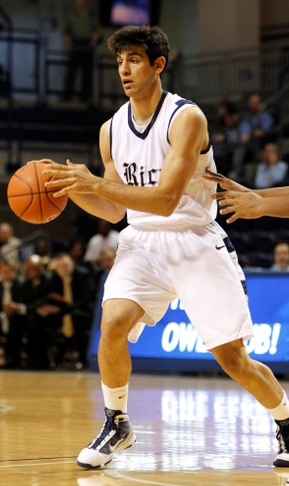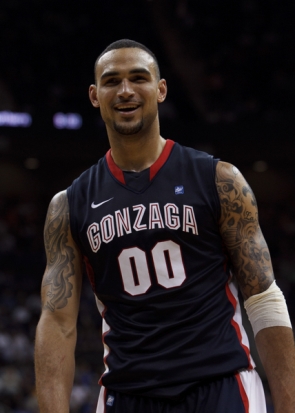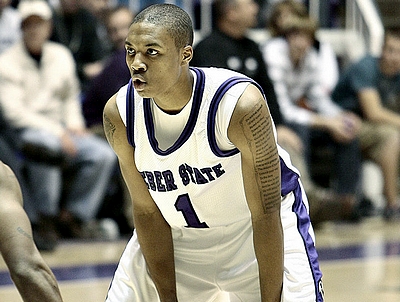Freshmen have been excluded from these previews, as we'd like to wait and see what they have to offer on the NCAA circuit before we come to any long-term conclusions.
-Top 20 Prospects in the Big Ten
-Top 25 Prospects in the ACC
-Top 15 Prospects in the Big 12
-Top 15 Prospects in the Pac-12
-Top 25 Prospects in the Big East
-Top 15 NBA Prospects in the SEC
-Top NBA Draft Prospects in the Non-BCS Conferences, Part One (#1-5)
#6 Damian Lillard, 6-2, Point Guard, Junior, Weber State

Joseph Treutlein
Coming off a breakout sophomore season that led to Big Sky Conference MVP honors, Damian Lillard had high expectations heading into his junior year. Lillard got off to a strong start, slightly improving his efficiencies and pace-adjusted productivity through his first nine games, but unfortunately suffered a season-ending injury when he broke his foot against Tulsa.
With his foot fully healed and a strong showing at the adidas Nations counselor games under his belt, Lillard will look to pick things up right where he left off to start the season. Not much changed from his perspective as a prospect in his shortened third year on campus, but Lillard did make some subtle improvements in a few areas and still has room for growth looking forward.
One interesting aspect of Lillard's game is his increasing confidence attacking the rim, as his pace-adjusted free throw attempts per 40 minutes have significantly increased all three of his years in school. A good athlete with long arms and a strong frame, Lillard has no problem driving right into the teeth of the defense and drawing contact, but it will be interesting to see if his healed foot has any lingering effect on his confidence or quickness this season.
Looking at Lillard's dribble drive game as a whole, there is much to be impressed with, ranging from his well-developed handle with both hands, his ability to change directions with ease in the lane, and his general awareness and tendency to always keep his head up with the ball. On the down side, however, despite a solid first step, Lillard doesn't stand out very much with his second or third gear, not often showing the ability to take it to the next level the way elite guards do. To his credit, his solid height and excellent length allow him to make up for this somewhat in the finishing department, where he does a good job scoring over (or going through) the competition, while also showing flashes of a developing floater that would further take advantage of his size.
Lillard is also extremely capable scoring the ball with his perimeter jump shot, having a natural ability to put the ball in the basket from anywhere on the floor, whether he's pulling up off the dribble or spotting up for a catch and shoot. Lillard shows excellent balance and feel pulling up in space, while having a lightning quick release and clear cut NBA three-point range. Lillard's shooting motion does have a noticeably low release point, however, which doesn't get him into trouble often against Big Sky competition, but certainly could be more of a problem in the NBA. Also, his shot selection, while necessary given the demands placed on him in Weber State's offense, would likely need to be curbed considerably in the NBA, which could be an adjustment.
The biggest question mark offensively for Lillard going forward is how much of a true point guard he's capable of being, something that's difficult to assess given the role he's forced to play in his current situation. While often bringing the ball up the floor, playing atop the key, and initiating his team's offense, Lillard looks to create his own shot more often than he does for teammates, and will likely need to make adjustments in the pros.
The most intriguing aspect of Lillard's point guard game is the prowess he shows in the pick-and-roll game, where he has both the vision to find his teammates along with the ability and feel to create his own shot either going to the basket or pulling up in space. Overall, he doesn't appear to be an especially selfish player and shows solid flashes in most aspects of a floor general's game, but whether he can fully embrace the different mentality necessary for the position at the NBA level is something he'll need to work on.
On the defensive end, Lillard seemed to make some strides in his limited action last season, showing an increased aggressiveness and commitment in man-to-man defense both on and off the ball. His lateral quickness is solid and he's doing a good job developing his fundamental base while also being fearless in playing up on his man even on drives to the basket. His smothering length is also a great asset contesting shots on drives in the lane, though it's worth noting all of these strengths would be notably muted against the bigger, more athletic guard competition he'd face outside his team's fairly weak schedule. Still, he has the tools to be at the least a decent defender in the NBA if he continues applying himself.
Looking forward, Lillard clearly brings a lot of skills to the table from an NBA perspective, but as with many small school scoring guards, the inevitable adjustment to a significant role change will be a question mark. The strides Lillard has made in his three years in college with his increased aggressiveness and expanding skill set are good signs, and it will be interesting to see if he can avoid any setbacks in his return from injury this season. Showing some improvements as a floor general and shot creator for his teammates would greatly help his stock, but is not very likely in his team's situation, so continuing to strive in all other areas and potentially making a run to the NCAA tournament is key.
#7 Will Barton, 6-6, SG/SF, Sophomore, Memphis
Having profiled Barton fairly late in the season with a comprehensive scouting report, we've elected to wait and see what type of progress he's made with a fresh perspective in a few months, rather than rehashing many of the same comments made last year based off his 2010-2011 game footage.
#8 Arsalan Kazemi, 6-8, Small Forward/Power Forward, Junior, Rice

Walker Beeken
After a solid freshman season in 2009-2010, Rice's Arsalan Kazemi had an outstanding year as a sophomore, averaging 15.2 points and 11 rebounds in 29.8 minutes per game. He now enters his junior season as one of the preseason favorites for Conference USA Player of the Year, and is a player that NBA scouts will likely be paying attention to, as they'll need to assess how his somewhat unorthodox game might translate to the NBA level.
As we mentioned before, Kazemi has an intriguing physical profile for an NBA prospect, standing at 6'8 with solid length and athleticism, and he enhances those physical tools with an excellent motor, seeming to have an extra gear than most anybody else on the court. His incredible effort level and aggressiveness enabled him to be one of the most productive players in all of college basketball last season (his 31.1 PER ranked 6th of all players in our database), despite his skill level and feel for the game still being a work in a progress.
Kazemi again played as a power forward as a sophomore and saw an increase in his role offensively, which he made the most of, increasing his scoring output while still shooting a solid 53% from the floor. About 32% of his touches came in the post, where he was very efficient and showed quite a bit more polish with his footwork and skill level than he did as a freshman. He fights hard for position, has a nice touch, and the ability to finish with both hands. His lack of size hinders his ability to finish at times, however, and will make it difficult to translate this part of his game to the NBA level.
He also showed the ability to catch the ball at the elbow and put the ball on the floor for a few dribbles to get to the rim, where he's able to utilize his quickness advantage against most college big men. He is relentless attacking the basket, as evidenced by him leading all players in our database in free throw attempts per possession last season.
His ball-handling, though improved, is still not refined enough for him to be an effective weapon on the wing, and although his energy and aggressiveness are usually his greatest assets, he has trouble harnessing them at times and can be a bit out of control and turnover-prone going to the basket, occasionally having tunnel vision and not seeing the floor.
We mentioned last season that Kazemi has the body and mobility that could allow him to make the transition to more of a full time small forward, but that remains somewhat of a stretch at this stage given his skill set. He hardly attempted a jumper all of his sophomore season, and although he improved his free throw percentage from 61% to 72%, he'll need to start showing the ability to knock down some perimeter jump shots.
Defensively, Kazemi primarily defends big men at Rice, and as we mentioned before, his lack of size can be a liability against the stronger, bulkier players he faces in the post in the post. He does look to have the lateral quickness to make the switch to defending more on the perimeter, but it might take some time to adjust.
Overall, Kazemi is an interesting prospect that scouts could have a wide range of opinions on, in terms of how well his game might translate to the next level. It's extremely hard to find anybody who plays as hard as he does, and his production at the college level can't be ignored. He still seems to be a bit stuck between positions, but if he can start to display more of a perimeter game this season, he could emerge as an intriguing combo forward prospect.
#9 Robert Sacre, 7'0, Senior, C, Gonzaga

Derek Bodner
After a foot injury caused him to miss most of what became a redshirted 2008-2009 campaign, senior center Robert Sacre has been a consistent contributor for the Gonzaga Bulldogs.
Standing a legitimate 7 feet with an NBA ready frame, it's easy to see where the intrigue around Sacre begins. Sacre uses his size well, getting the majority of his half-court offense in the post, where most teams simply do not have the size to match up with him. Sacre does a good job of establishing position early and sealing off his defender, giving his teammates a clear entry pass and forcing defenders to foul, where his 8.5 free throw attempts per 40 minutes pace adjusted rank as one of the top numbers among centers in our database.
His post game, while still not overly diversified, has seen slight improvement. He's showing more over his right shoulder and has added a baseline spin move to go along with his more preferred moves, a right handed hook shot and turnaround fade-away jump shot. It's still fairly methodical and slow developing, but if he can continue to show increased diversity it will help him offset some of his athletic limitations.
His lack of explosiveness is the biggest question mark in projecting his post game to the next level, as he is neither overly quick out of his moves or explosive as a leaper, and he has his shot blocked more than you would hope for considering the size advantage he has on most nights. With the increased length and athleticism at the next level, and not having the kind of offensive diversity to date that would offset a drop in his productivity in the post, it brings into question how much of an offensive factor he could be at the next level.
Sacre's biggest offensive contributions outside of post-up situations has been on the offensive glass, where he effectively uses his size and high effort level to be a good offensive rebounder. He also moves well without the ball and has solid hands, although both of these strengths are again somewhat offset by his lack of vertical explosion and at times difficulty finishing in traffic, although his ability to get position and get fouled allows him to be efficient in these sets.
Sacre's improvement as a jump shooter is perhaps the area of his game that could help him the most. He appeared to improve somewhat as a set shooter, although the sample size is still small enough that he still has a lot to prove in this regard. His improvement in free throw percentage, from 62.9% to 82.3%, this past year, provides some level of comfort that this is an area that Sacre could add to his game, and it is paramount to his success at the next level.
Sacre is a very effective defender at the collegiate level, both in terms of team and man to man defense. He appears to get in a good stance defending the pick and roll and moves his feet better than expected, although he can be burned by misdirections and double moves, as he sometimes struggles to change direction. His defensive rotations aren't the quickest, but he appears to be a smart defender and has good recognition and knowledge of team concepts, and his length and timing allows him to be a weak side shot blocker. In the post is where he is the most comfortable defensively, and where he shows the most promise at the next level, as he does a good job of denying deep post position and uses his length to effectively disrupt offensive players.
Sacre's poor defensive rebounding -- his 5.8 defensive rebounds per 40 minutes pace adjusted ranks amongst the worst numbers for centers in our database, albeit an improvement over his 2009-2010 year -- is the other area that makes projecting him to the next level difficult. With the expected drop in offensive usage at the next level it would be much easier to project him as a role player if he was more of a contributor in this regard. He simply doesn't appear to be all that instinctual of a rebounder on this end of the court and he doesn't have the athleticism or quickness to make up for that.
Sacre's size and physical tools will continue to garner attention throughout the season, and much attention will likely be given to defensive ability and how that might translate. Showing scouts that he has the potential to develop an effective mid-range jump shot, allowing him to transition to an off the ball scorer away from being a primary focus in the post, could help as well. Perhaps most important will be whether he can shore up his defensive rebounding to allow him to be a consistent contributor even when his number is not being called offensively.
#10 Elias Harris, 6-7, Junior, Power Forward, Gonzaga
Having profiled Harris fairly late in the season with a comprehensive scouting report, we've elected to wait and see what type of progress he's made with a fresh perspective in a few months, rather than rehashing many of the same comments made last year based off his 2010-2011 game footage.
































Comments